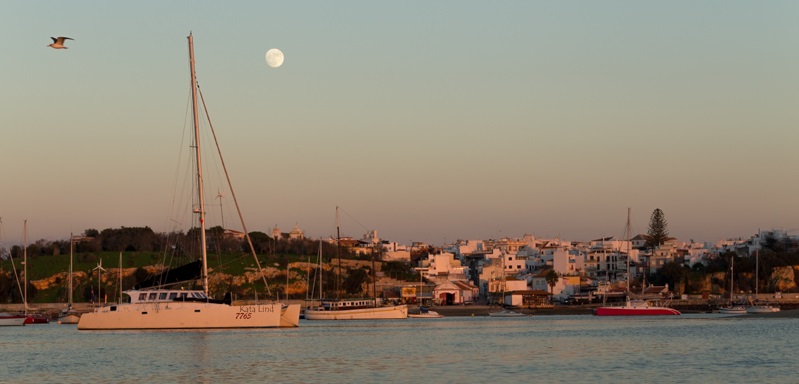When I get other people sailing on my boat, they are amazed how Kata Lind is able to keep her course, straight, almost like a cargo ship, even on a bad sea, with a limited action on the rudder. So they all ask or check directly what kind of autopilot I have because they want the same. Then I switch to the compass number 2 and they are not impressed anymore at all. The rudder is working « normally » (means a lot more) and the boat keeps its course normally (means not perfectly straight).
You have already understood, the ability of my boat to keep the course has nothing to do with the autopilot but with the compass. Unlike most of pleasure boats, I am not using a magnetic compass but a GPS compass. An really old GPS compass KGC-1 from Koden. And that makes a huge difference, specially in the north sea.
Some explanation.
The eyes of our boat’s autopilots are the compass (except racing sail boat but that’s another story). Bad compass, bad driving by the autopilot even with the best autopilot in the world.
All autopilots for pleasure boats come with a magnetic compass. They call it fluxgate, Gyro, rate compass, solid state compass….., doesn’t matter, it’s always the same, it’s based on a magnetic compass with a certain number of accelerometers to stabilize as much as possible the output of this magnetic compass. Some are better than others. It’s a huge improvement compared to a simple magnetic compass, but it’s not perfect. A magnetic compass is really much affected by the motion of the boat (pitch and roll) and by the magnetic field that is not perfect (specially on north sea). So the output of the magnetic compass is not stable. (it means that even if your boat is not turning at all, keeping a perfect straight line, the output of the magnetic compass will turn because of the motion of the boat). By adding all this accelerometers, manufacturers can reduce these errors, but not all of them. Concretely, it means that the autopilot will think that your boat is turning when not, or invert. Because the autopilot « sees » through the compass, it’s the only way for the autopilot to see if the boat is turning or not. So when the compass sends an incorrect information, the autopilot will make an unnecessary correction, and unnecessary action on the rudder, that will have to be cancelled later. 1 mistake from the compass, at least 2 unnecessary actions on the rudder. And during this time the boat is not keeping his course. And when there is too much error from the compass, on heavy sea, it’s probably the reason why the autopilot is not able anymore to steer the boat. It’s most of the time not the fault of the autopilot, but the fault of a bad compass.
The compass number 2 on my boat is the original magnetic compass solid state with 3 accelero meters of the autopilot. Perfect for backup compass.
My compass number 1, allowing the autopilot to steer so well that most people notice, is a GPS compass.
A GPS compass is NOT a magnetic compass.
A GPS compass is NOT the COG given by a normal GPS.
A GPS compass is an instrument that will use at least 2 GPS antennas and will find the course of the boat by analyzing the phase shift between the signals received by both GPS antennas sent from GPS satellites. It sounds complicated, it’s complicated, that’s why we had to wait till the 21. century to see first models for public, really expensive at first, but now it becomes accessible and more common but still expensive. The GPS compass will give you a really accurate course, even on bad sea, even on north or south pole, even on a steel boat because it does not use the magnetic field of the earth. Kata Lind has an old Koden GPS compass, first generation of GPS compass, still working like when new, even if not perfect (the first generation of GPS compass trend to lose sometimes the satellite signal). I got if from a fisherman that got the new version of GPS compass from Koden, the KGC-222, I thank him. So with this GPS compass, Kata Lind is always under autopilot, always on course, even in really bad sea 3/4 rear or whatever. When I put the backup magnetic compass, it’s not that good. The difference is important, especially on bad sea, and critical on 55°north or more.
Some people that will read this article will think, « Yes, I am going to take a look at a GPS compass and buy it, it will solve my autopilot problem ». Unfortunately it’s not that easy, you need to have an autopilot with an compass NMEA input. And unfortunately (again), most of autopilots for pleasure boats do not have a compass NMEA input. So it means that you have to use the compass from the manufacturer. And it’s really a shame. Because adding a GPS compass to your system is really a good way to significantly improve the ability of your autopilot.
In Iceland, I have installed plenty of autopilots. Most of them with GPS compass as primary compass. Then no problem, perfectly working, customer happy. But some of them could not purchase a GPS compass right away. With the conditions of Iceland (rough sea and weak vertical magnetic field) it was a headache to get autopilots (of whatever brand) without GPS compass working correctly. I am not talking about keeping a course, that’s too much to ask, when we were getting +-20° around the course order, it was really good. As soon as they could get a GPS compass, the boat was like a train on a track…
